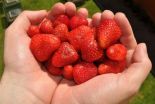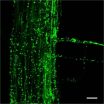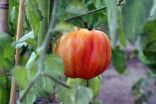(Press-News.org) Salmon conservation shouldn't narrowly focus on managing flows in streams and rivers or on preserving only places that currently have strong salmon runs.
Instead, watersheds need a good mix of steep, cold-running streams and slower, meandering streams of warmer water to keep options open for salmon adapted to reproduce better in one setting than the other, new research shows.
Preserving that sort of varied landscape serves not just salmon, it provides an all-summer buffet that brown bears, gulls and other animals need to sustain themselves the rest of the year.
"In any one stream, salmon might spawn for two to four weeks," said Peter Lisi, a University of Washington doctoral student in aquatic and fishery sciences, who studies the Wood River watershed in southwest Alaska.
"Animals like coastal brown bears and Glaucus-winged gulls gorge themselves at one stream for a few weeks and then just move to another stream that might have water temperatures a few degrees warmer and therefore support salmon populations that spawn at a later time," he said. "It's easy for animals to move when such streams are as little as a mile or two apart."
A whole network of streams, some colder and some warmer, provides what Lisi and Daniel Schindler, UW professor of aquatic and fishery sciences, call "hydrological diversity." Such diversity more than triples the time predators have access to salmon in a summer, from just a few weeks to more than three months in the watershed studied.
The researchers' paper on landscape attributes that influence spawn times will be presented Aug. 8 in Portland, Ore., during the Ecological Society of America's annual meeting.
"Both Glaucus-winged gulls and brown bears have very short growing seasons at high latitudes. Salmon are a key resource that allows these species to fatten up and achieve the necessary annual growth in this short period of time," Schindler said. "A complex landscape results in streams of differing temperature so salmon populations don't spawn at the same time. Predators and scavengers have a much longer window of accessibility."
"We knew that salmon are an important seasonal resource for lots of predators and consumers. However, there is little appreciation for the importance of biological diversity within salmon for these consumers."
The response of salmon to hydrologic diversity is what makes stocks viable over time and will probably make them better able to respond to climate change, Lisi said. Instead of focusing narrowly on flow regimes or trying to decide which individual streams and rivers to protect, a better goal would be to protect a wide range of hydrologic conditions, the co-authors said.
"Biological diversity within salmon stocks has important benefits to terrestrial ecosystems," Schindler said. "This scale of variation in hydrology, geomorphology and biological diversity is often swept under the rug and dismissed as unimportant in activities such as river restoration, projections of climate impacts and fishery management."
The paper, part of a session on linkages between aquatic and terrestrial systems, also describes how biological diversity in returning salmon are linked to the pollination of a flowering plant, something no other group has described.
Populations of kneeling angelica, 3-to-6-foot plants loaded with clusters of tiny white blossoms, don't all bloom at the same time, even though sun and weather conditions might be uniform across a watershed. Instead, these streamside plants have evolved to bloom approximately 10 days after salmon typically arrive at a particular stream.
It takes about that long for salmon to start to die, many of which are killed by bears or die naturally after spawning. Blowflies lay eggs on the carcasses and the result is a population boom of maggots to take advantage of all the dead salmon. Those maggots emerge as adult blowflies the next summer just in time for the salmon run. Before laying their eggs, the blowflies swarm kneeling angelica flowers to feed on nectar, spreading pollen at the same time.
Previous research has looked at direct connections to plants, such as roots taking up nutrients when salmon carcasses decay, Lisi said. This is an indirect consumer pathway.
"Kneeling angelica are among the last plants to bloom. It's fall, everything else is dying, most of the insects are gone but these plants hold out for the arrival of salmon," Lisi said.
INFORMATION:
The work is funded by the Gordon and Betty Moore Foundation, National Science Foundation and Western Alaska Landscape Conservation Cooperative through the U.S. Fish and Wildlife Service.
For more information:
Lisi, pjlisi@uw.edu, 206-359-0470 (after Aug. 10, he's out of cell contact for rest of summer)
Schindler, deschind@uw.edu, 907-842-2534
Suggested websites
Peter Lisi
http://fish.washington.edu/research/schindlerlab/gradstudents.html
Daniel Schindler lab
http://fish.washington.edu/research/schindlerlab/index.html
Abstract of Ecological Society of America presentation
http://eco.confex.com/eco/2012/webprogrampreliminary/Paper38567.html
Ecological Society of America annual meeting
http://www.esa.org/portland/
Find press release online at
http://www.washington.edu/news/2012/08/02/bears-scavengers-count-on-all-you-can-eat-salmon-buffet-lasting-for-months/
Bears, scavengers count on all-you-can-eat salmon buffet lasting for months
2012-08-03
ELSE PRESS RELEASES FROM THIS DATE:
Invasive insects cause staggering impact on native tree
2012-08-03
The beautiful, endemic and endangered cycad, Cycas micronesica was once a dominant forest tree on the island of Guam, but recent plant mortality predicts extirpation from Guam habitats by 2019. This dire prediction by scientists at the Western Pacific Tropical Research Center (WPTRC), University of Guam is validated by the research of Thomas E. Marler and John H. Lawrence, which has concluded that Cycas micronesica is the only native host for the invasive scale insect Aulacaspis yasumatsui. "The potential cascading ecosystem responses are yet to be completely understood," ...
UT MD Anderson study finds link between depressive symptoms and cancer survival
2012-08-03
HOUSTON — Research from The University of Texas MD Anderson Cancer Center has found that symptoms of depression in patients with newly diagnosed metastatic kidney cancer are associated with survival and inflammatory gene regulation may explain this link.
The study, published in the journal PLoS ONE, further explores the interplay between patient psychological condition, stress hormone regulation and the role of inflammatory gene expression. Although previous research indicates depression is connected with worse outcomes, questions remain about the specific factors involved.
"Our ...
Unexpected variation in immune genes poses difficulties for transplantation
2012-08-03
Human HLA genes – the genes that allow our immune system to tell the difference between our own cells and foreign invaders – are evolving much more rapidly than previously thought, according to an article online on August 3rd in Trends in Genetics. The resulting degree of variation improves our ability to fight off disease, but could also present challenges to current worldwide efforts aimed at identifying potential donors for patients undergoing stem cell transplantation.
"This new work makes clear the daunting and near hopeless challenge of keeping track of the continuous ...
Strawberry extract protects against UVA rays
2012-08-03
An experiment has shown that strawberry extract added to skin cell cultures acts as a protector against ultraviolet radiation as well as increasing its viability and reducing damage to DNA. Developed by a team of Italian and Spanish researchers, the study opens the door to the creation of photoprotective cream made from strawberries.
"We have verified the protecting effect of strawberry extract against damage to skins cells caused by UVA rays," as explained to SINC by Maurizio Battino, researcher at the Università Politecnica delle Marche in Italy and lead author of the ...
How the cell swallows
2012-08-03
VIDEO:
Scientists at EMBL have combined the power of two kinds of microscope to produce a three-dimensional movie of how cells ‘swallow’ nutrients and other molecules by engulfing them. The study...
Click here for more information.
Scientists at the European Molecular Biology Laboratory (EMBL) in Heidelberg, Germany, have combined the power of two kinds of microscope to produce a 3-dimensional movie of how cells 'swallow' nutrients and other molecules by engulfing them. The ...
Bacterial community inside the plant root
2012-08-03
This press release is available in German.Soil is the most species-rich microbial ecosystem in the world. From this incredible diversity, plants specifically choose certain species, give them access to the root and so host a unique, carefully selected bacterial community from which they then benefit in a variety of ways. To achieve this, the plant's immune system must be able to tell which of these bacteria are friends and which foes. Researchers from the Max Planck Institute for Plant Breeding Research in Cologne and the Max Planck Institute for Marine Microbiology in ...
Ethylene of no effect -- why peppers do not mature after picking
2012-08-03
This press release is available in German.Tomato breeders scored a coup several years ago when they identified tomatoes with a genetic defect that made the fruits mature very slowly, even under the influence of the phytohormone ethylene. Traders and growers were delighted as it gave them more time to transport the crop, initially still green, from where it was harvested to where it would be sold. At the stores, the tomatoes could then be treated with ethylene to bring them to maturity. Other fruits, like peppers, grapes and strawberries, generally do not mature after picking; ...
Mystery of elephant infrasounds revealed
2012-08-03
Elephants can communicate using very low frequency sounds, with pitches below the range of human hearing. These low-frequency sounds, termed "infrasounds", can travel several kilometers, and provide elephants with a "private" communication channel that plays an important role in elephants' complex social life. Their frequencies are as low as the lowest notes of a pipe organ.
Although the sounds themselves have been studied for many years, it has remained unclear exactly how elephant infrasounds are made. One possibility, favored by some scientists, is that the elephants ...
MAK value lowered for chlorinated biphenyls
2012-08-03
This press release is available in German.Chlorinated biphenyls (PCBs) are a group of substances for which the 2012 List of MAK and BAT Values submitted by the Senate Commission for the Investigation of Health Hazards of Chemical Compounds in the Work Area of the Deutsche Forschungsgemeinschaft (DFG, German Research Foundation) specifies new, and in this case, significantly lower values than previously recommended. The current list, which was presented to the German Federal Minister of Labour and Social Affairs as in every year, and which is the basis for legislation on ...
NUS researchers identify a novel double-stranded DNA structure
2012-08-03
Contact: Tsueyling Yong
sciytl@nus.edu.sg
65-651-67874
Carolyn Fong
Carolyn@nus.edu.sg
65-6516-5399
National University of Singapore
NUS researchers identify a novel double-stranded DNA structure
Researchers' findings address a scientific debate that had lasted for 16 years over the existence of a double-stranded DNA structure
Double-stranded DNA has often been described as a right-handed helical structure, known as B-DNA. To perform its multiple functions, double-stranded DNA has multiple structures depending on conditions. For example, the melted DNA ...





